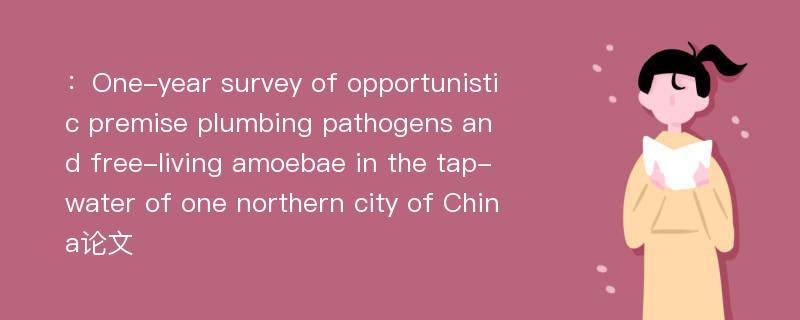
本文主要研究内容
作者(2019)在《One-year survey of opportunistic premise plumbing pathogens and free-living amoebae in the tap-water of one northern city of China》一文中研究指出:In this study, qPCR was used to quantify opportunistic premise plumbing pathogens(OPPPs) and free-living amoebae in 11 tap water samples collected over four seasons from a city in northern China. Results demonstrated that the average numbers of gene copies of Legionella spp. and Mycobacterium spp. were significantly higher than those of Aeromonas spp.(p < 0.05). Legionella spp. and Mycobacterium spp. were 100%(44/44) positively detected while P. aeruginosa and Aeromonas spp. were 79.54%(35/44) and 77.27%(34/44) positively detected. Legionella pneumophila was only detected in 4 samples(4/44), demonstrating its occasional occurrence. No Mycobacterium avium or Naegleria fowleri was detected in any of the samples. The average gene copy numbers of target OPPPs were the highest in summer,suggesting seasonal prevalence of OPPPs. Average gene copy numbers of OPPPs in the taps of low-use-frequency were higher than in taps of high-use-frequency, but the difference was not significant for some OPPPs(p > 0.05). Moderate negative correlations between the chlorine concentration and the gene copy numbers of OPPPs were observed by Spearman analysis(rsranged from -0.311 to -0.710, p < 0.05). However, no significant correlations existed between OPPPs and AOC, BDOC, or turbidity. Moderate positive correlations were observed between the target microorganisms, especially for Acanthamoeba spp., through Spearman analysis(p < 0.05). Based on our studies, it is proposed that disinfectant concentration, season, taps with different-use frequency, OPPP species, and potential microbial correlations should be considered for control of OPPPs in tap water.
Abstract
In this study, qPCR was used to quantify opportunistic premise plumbing pathogens(OPPPs) and free-living amoebae in 11 tap water samples collected over four seasons from a city in northern China. Results demonstrated that the average numbers of gene copies of Legionella spp. and Mycobacterium spp. were significantly higher than those of Aeromonas spp.(p < 0.05). Legionella spp. and Mycobacterium spp. were 100%(44/44) positively detected while P. aeruginosa and Aeromonas spp. were 79.54%(35/44) and 77.27%(34/44) positively detected. Legionella pneumophila was only detected in 4 samples(4/44), demonstrating its occasional occurrence. No Mycobacterium avium or Naegleria fowleri was detected in any of the samples. The average gene copy numbers of target OPPPs were the highest in summer,suggesting seasonal prevalence of OPPPs. Average gene copy numbers of OPPPs in the taps of low-use-frequency were higher than in taps of high-use-frequency, but the difference was not significant for some OPPPs(p > 0.05). Moderate negative correlations between the chlorine concentration and the gene copy numbers of OPPPs were observed by Spearman analysis(rsranged from -0.311 to -0.710, p < 0.05). However, no significant correlations existed between OPPPs and AOC, BDOC, or turbidity. Moderate positive correlations were observed between the target microorganisms, especially for Acanthamoeba spp., through Spearman analysis(p < 0.05). Based on our studies, it is proposed that disinfectant concentration, season, taps with different-use frequency, OPPP species, and potential microbial correlations should be considered for control of OPPPs in tap water.
论文参考文献
论文详细介绍
论文作者分别是来自Journal of Environmental Sciences的,发表于刊物Journal of Environmental Sciences2019年03期论文,是一篇关于,Journal of Environmental Sciences2019年03期论文的文章。本文可供学术参考使用,各位学者可以免费参考阅读下载,文章观点不代表本站观点,资料来自Journal of Environmental Sciences2019年03期论文网站,若本站收录的文献无意侵犯了您的著作版权,请联系我们删除。
